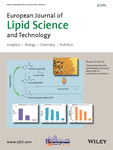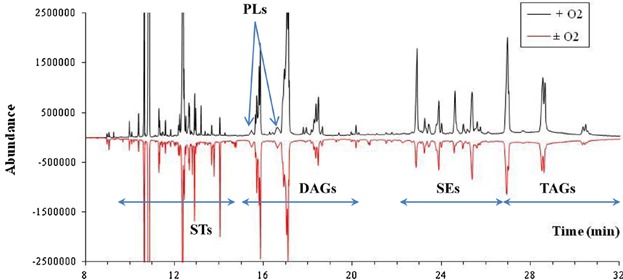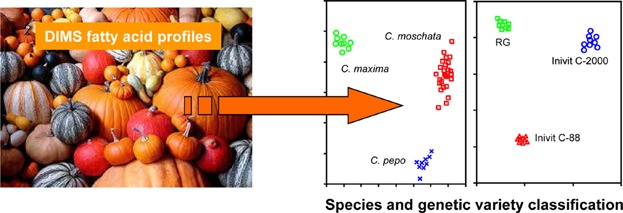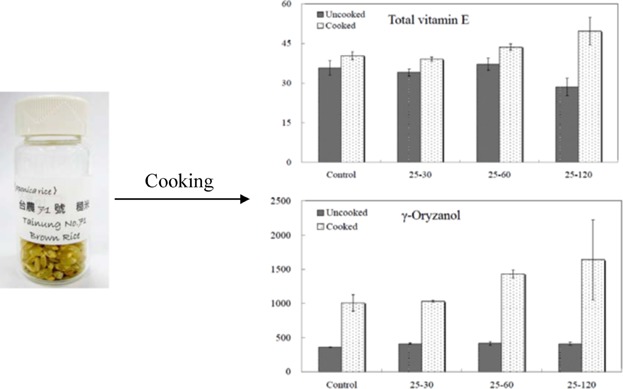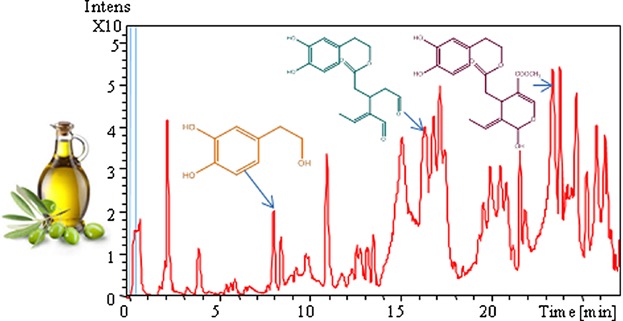Journal list menu
Export Citations
Download PDFs
Cover Picture
Cover Picture: Eur. J. Lipid Sci. Technol. 3∕2015
- First Published: 09 March 2015

There is considerable interest in antioxidants from natural sources for food uses. Phenolic acids are excellent antioxidants, widely occurring in plants, but their applications in oil-based formulations is limited. In this study, a two-step chemoenzymatic lipophilization of phenolic acids with policosanols, which are long-chain aliphatic primary alcohols extracted from plant waxes, was carried out to improve their antioxidant activity against lipid oxidation. The resulting policosanyl phenolates showed eff ective antioxidant activities in linoleic acid model system and in cooked pork model system.
Editorial Board
In this Issue
Contents
Editorial
Camelina—a promissing oilseed crop to contribute to the growing demand for vegetable oils
- Pages: 271-273
- First Published: 09 March 2015
Short Communication
A simple method for the separation and quantification of neutral lipid species using GC-MS
- Pages: 274-280
- First Published: 13 August 2014
Research Articles
Beneficial impact of a mix of dairy fat with rapeseed oil on n-6 and n-3 PUFA metabolism in the rat: A small enrichment in dietary alpha-linolenic acid greatly increases its conversion to DHA in the liver
- Pages: 281-290
- First Published: 03 October 2014
Maternal use of a diet rich omega-3 from flaxseed improves aortic remodeling but not the biochemical parameters of female offspring of diabetic rats
- Pages: 291-299
- First Published: 06 October 2014
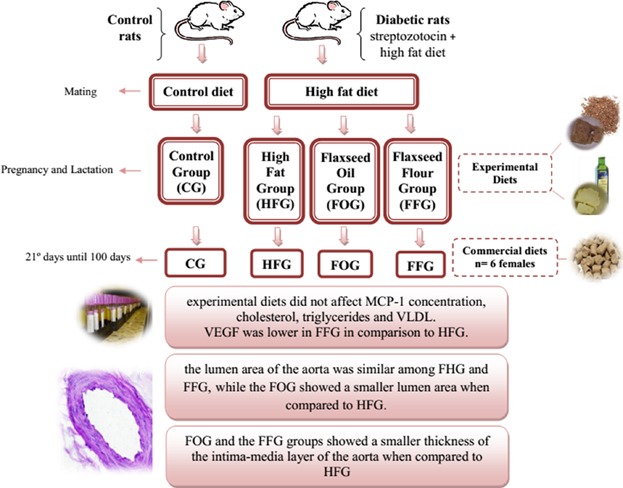
We evaluated the influence of maternal ingestion of a high fat diet with added flaxseed flour and flaxseed oil during pregnancy and lactation on the morphology and biochemical parameters of the aorta in the female offspring of diabetic rats 100 days of life. It was observed that experimental diets did not altered the biochemical parameters of their offspring when they reached adult age. However it is suggested that there was a beneficial action promoted by maternal consumption of flaxseed meal or flaxseed oil against aortic remodeling of offspring at 100 days of life.
Chemoenzymatically synthesized policosanyl phenolates as autoxidation inhibitors
- Pages: 300-310
- First Published: 28 August 2014
Rapid quantification of polar compounds in thermo-oxidized oils by HPTLC-densitometry
- Pages: 311-319
- First Published: 03 October 2014
Comparison of volatile compounds of hot-pressed, cold-pressed and solvent-extracted flaxseed oils analyzed by SPME-GC/MS combined with electronic nose: Major volatiles can be used as markers to distinguish differently processed oils
- Pages: 320-330
- First Published: 15 September 2014
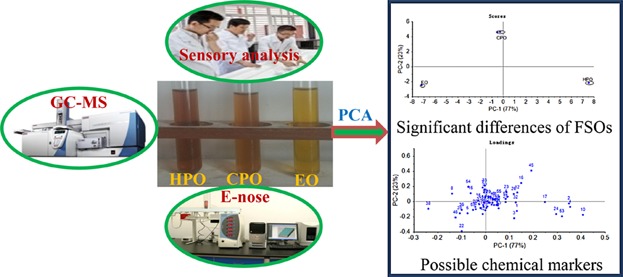
Sixty-one volatiles were identified and significant differences were found in different processed flaxseed oils. Twelve major volatile compounds contributed to discrimination of different processed flaxseed oils. Flaxseed oil samples were distinguished from each other through PCA of E-nose data, suggesting that the E-nose can successfully discriminate different processed flaxseed oils.
Statistical classification of pumpkin seed oils by direct infusion mass spectrometry: Correlation with GC-FID profiles
- Pages: 331-337
- First Published: 03 October 2014
Oil composition in stored walnut cultivars—quality and nutritional value
- Pages: 338-348
- First Published: 13 August 2014
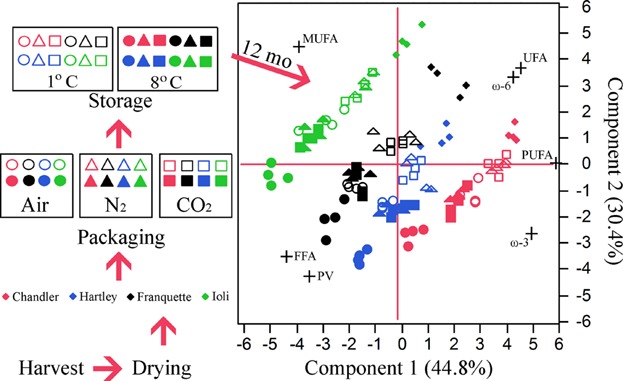
Effects of temperature and packaging atmosphere on rancidity and nutritional value related to oil composition in stored dried kernels of walnut (Juglans regia L.) cultivars. The present results are summarized in the bi-plot (combination of score and load plots) of Principal Component Analysis. Each color corresponds to each cultivar. Rhombuses, circles, squares, and triangles, corresponding to different storage conditions, indicate the position of each walnut sample in score plot. Daggers indicate the position of major fatty acids and indicators of rancidity in load plot.
Effects of cooking conditions on the concentrations of extractable tocopherols, tocotrienols and γ-oryzanol in brown rice: Longer cooking time increases the levels of extractable bioactive components
- Pages: 349-354
- First Published: 12 September 2014
Chemical composition, thermal stability and antioxidant properties of tea seed oils obtained by different extraction methods: Supercritical fluid extraction yields the best oil quality
- Pages: 355-365
- First Published: 18 October 2014
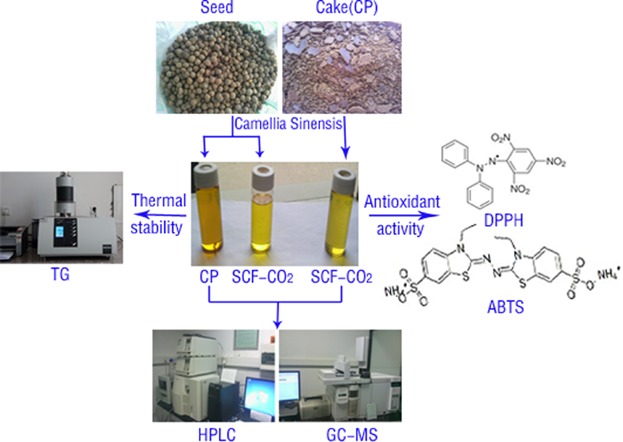
A comparison study has been performed for tea seed oils (TSO) extracted from different methods and sources, which were oil from cold-pressing of tea seeds [TSO(CP)], oil from supercritical fluid extraction of seeds [TSO(SCF)], and oil from supercritical fluid extraction of tea seed cake [TSCO(SCF)]. The chemical composition, thermal stability, antioxidant properties, and physicochemical properties of the oils were determined.
Correlation of fatty acid composition of virgin olive oil with thermal and physical properties
- Pages: 366-376
- First Published: 13 August 2014
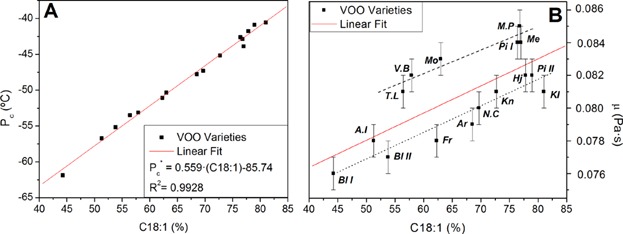
Correlations between the oleic acid (C18:1) content of VOOs and the corresponding to (A) temperature of the major peak of crystallization phase (Pc) and (B) dynamic viscosities (µ). The aim of this work is to study not only thermal properties from thermal profiles (crystallization, melting, and oxidation curves) by DSC measurements, but also physical characterization (density and viscosity) as a function of temperature of VOOs from 14 different olive cultivars, in order to relate thermal and physical properties with chemical composition (FA). As can observed, there is a high correlation between temperature of the peak of crystallization phase, Pc, and FAs composition (C18:1). Moreover, although non good correlations between oil viscosity and fatty acid composition could be found, the viscosity tends to increase as the amount of C18:1 fatty acid.
Oil biogenesis and antioxidant compounds from “Arauco” olive (Olea europaea L.) cultivar during fruit development and ripening
- Pages: 377-388
- First Published: 08 October 2014

Mesocarp cells from cv. “Arauco” drupes (about 160 days after full flowering, DAFF) showing a single, spherical, large oil droplet per cell. Oil biogenesis is complete at very early stages of fruit maturity. Findings remark on the convenience of early harvest (at a low fruit maturity index) to get the best combination of oil quantity and quality.
Time course of Algerian Azeradj extra-virgin olive oil quality during olive ripening
- Pages: 389-397
- First Published: 23 July 2014
An integrated analytical approach for the compositional evaluation of different stages of fully ripened Jatropha curcas seed oil
- Pages: 398-405
- First Published: 05 November 2014
Synthesis of KF/CaO as a catalyst for the production of bio-fuel from cracking of Cornus wisoniana oil
- Pages: 406-410
- First Published: 18 July 2014




